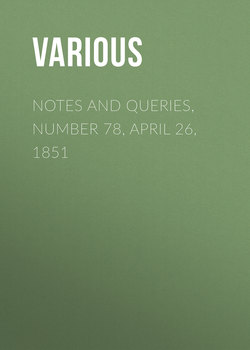Читать книгу Notes and Queries, Number 78, April 26, 1851 - Various - Страница 8
Notes
POETICAL COINCIDENCES, ETC
ОглавлениеByron
In the Jealous Lovers of Thomas Randolph, the following passage occurs, which may possibly have suggested to Lord Byron the fearful curse he has put into the mouth of Eve, in "the grand and tremendous drama of Cain."1
"May perpetual jealousie
Wait on their beds, and poison their embraces
With just suspitions; may their children be
Deform'd, and fright the mother at the birth:
May they live long and wretched; all men's hate,
And yet have misery enough for pity:
May they be long a-dying—of diseases
Painful and loathsome," &c.
That exquisite stanza in the Third Canto of Childe Harold, "Even as a broken mirror," &c., has been often admired. In Carew's poem, The Spark, I find the following lines, which contain similar image:
"And as a looking-glass, from the aspect,
Whilst it is whole, doth but one face reflect,
But being crack'd, or broken, there are shown
Many half faces, which at first were one;
So Love," &c.
To the coincidences which have been already pointed out regarding that exquisite line in the Bride of Abydos:
"The mind, the music breathing from her face,"
the following from Carew may perhaps be added:
"The harmony of colours, features, grace,
Resulting airs (the magic of a face)
Of musical sweet tunes, all which combin'd,
To crown one sovereign beauty, lie confined
To this dark vault."—Epitaph on the Lady S.
All will recollect the wonderful description of the shipwreck in Don Juan; and more particularly the incidents so graphically related in stanzas 52 and 53 of the Second Canto: to a part of which, the following passage fro Lee's Œdipus bears some resemblance:
"Methought I heard a voice,
Now roaring like the ocean, when the winds
Fight with the waves; now in a still small tone
Your dying accents fell, as wrecking ships,
After the dreadful yell, sink murm'ring down,
And bubble up a noise."
I have now before me a print of John, the first Lord Byron, engraved from a painting in the collection of Lord Delaware; in which he is pourtrayed in armour, with a truncheon in the left hand, and the right arm bare to above the elbow. Can this have suggested to Lord Byron the idea of describing "Alp the renegade" as fighting with "the white arm bare," in the Siege of Corinth?
Byron refers to Smollett as an authority for "blatant beast," apparently forgetting that the figure originated with Spenser. Again, in a note to Don Juan
1
Sir Walter Scott.
